
(Photo by gerry morgan)
Singapore is home to many species of snake, from tiny burrowing blind snakes less than 20 centimetres long, feeding on soft-bodied invertebrates in the soil, to gigantic pythons more than 5 metres in length, lurking in our drains and sewers in pursuit of rats and even stray cats. While most of our snakes are quite harmless, our forests have their fair share of kraits, coral snakes and pit vipers, with venomous bites that are a genuine cause for concern. The equatorial spitting cobra (Naja sumatrana) is perhaps the most dangerous of our venomous snakes, since it is commonly encountered living near people. Yet these serpents, for all their deadly beauty, pale in comparison to a snake so feared and so iconic that it has become a symbol of the Asian rainforests, a true superstar among the snakes - the king cobra (Ophiophagus hannah).
The King of Snakes

(Photo by hamadryad)
The king cobra (also known in the past as the hamadryad) is a terrestrial and diurnal snake, although it is also a capable climber and excellent swimmer. It has a wide distribution that spans across much of tropical Asia, from southern India through southern China and Indochina, Thailand, Malaysia and much of Indonesia, all the way to Sulawesi and the Philippines. While only a single species of king cobra is recognised for now, there is some degree of geographical variation in physical appearance. It is possible that future research will discover that what we now call the king cobra may actually be made up of several different species.
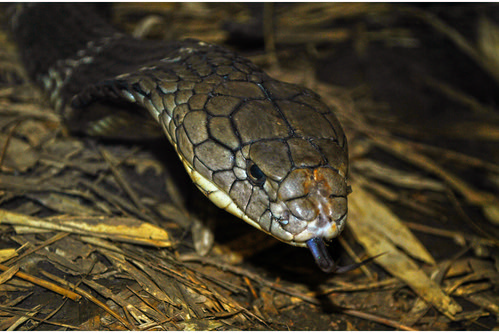
(Photo by Parth Jha Photography)
This is a true giant among snakes; with a maximum recorded length of 5.85 metres, it is the world's longest venomous snake. Like the smaller cobras, it rears up and expands its hood to face a potential threat, but its hood is narrower and lacks the markings often seen on many cobras. The key difference though is height; it is said that a large king cobra is able to rear up to look a man in the eye! And while many snakes will hiss loudly to warn predators to back off, the king cobra's warning hiss is often described as more like a low menacing growl. Certainly, coming face to face with an angry king cobra must be a most intimidating experience.

(Photo by ari-)
This threatening display is not an act. The king cobra packs a deadly punch, with venom full of toxins that affect the nervous system and the heart. While the king cobra's venom is not as deadly as that found in a number of other snake species, it more than makes up for it in terms of the sheer volume of venom injected. A single bite can kill a human within half an hour, and even fell elephants.

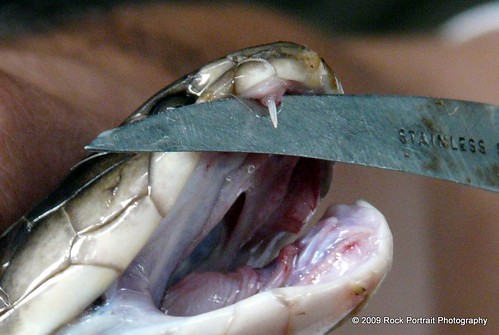
Showing off 1 of the king cobra's fangs, Phuket;
(Photos by Rock Portrait Photography)
Snake Eater
However, the king cobra uses its venom mostly to subdue its prey, which consists almost entirely of other snakes. Yes, the king cobra eats mostly other snakes. This video clip from a National Geographic documentary shows a king cobra killing and feeding on a rat snake, probably the oriental rat snake (Ptyas mucosa).
The king cobra sinks its fangs into its victim and clamps down hard. Both snakes may end up getting entwined together as the prey struggles to escape. The venom works on the nervous system, stopping the heart and paralysing muscles, and the lungs cease functioning. Within a few minutes, the snake succumbs and suffocates. The king cobra slowly swallows it whole, usually headfirst.
In fact, Ophiophagus, which is the generic name of the king cobra, translates to "snake-eater" in Greek, ophio- meaning "snake" and -phagus meaning "to eat". It is a very apt description of the king cobra, which is even known to be cannibalistic.
King cobra feeding on gold-ringed cat snake (Boiga dendrophila)
This next video from India depicts a king cobra feeding on an ordinary cobra (Naja sp.), showing that even other venomous snakes are targeted by this king of serpents. Perhaps it is like the kingsnakes (Lampropeltis spp.) of the Americas, in that it is immune to the venom of its prey. In fact, king cobras appear to possess some immunity to their own venom, which probably helps in avoiding attempts at cannibalism.
Even the largest snakes in the jungle are not immune to predation by the king cobra. This next video is not narrated in English, but it shows a clash between 2 of the most powerful snakes in Southeast Asia - a king cobra and a reticulated python (Broghammerus reticulatus), albeit a small one. It must be an awesome spectacle to behold; 2 large snakes locked in a deadly embrace, venom against constricting coils. Things don't always go the king cobra's way though; there are records of king cobras ending up being constricted by pythons.
King cobras will occasionally eat other prey, although such known records are rare. Radiographs taken of a large male king cobra caught at Rifle Range Road in 2000 revealed that it had swallowed a monitor lizard (Varanus sp.).
King cobra feeding on Indian python (Python molurus), India;
Such a specialised diet presents a problem for those who keep king cobras in captivity. Many captive snakes soon adapt to eating rats and mice, since rodents already are their natural prey, but how do you feed a snake that only eats other snakes?
For many, the simplest solution is to obtain live snakes and just place them in the king cobra's enclosure when it's feeding time.
It's not a pretty sight.
Captive king cobra eating live Oriental whip snake (Ahaetulla prasina), Malaysia;
Captive king cobra eating live gold-ringed cat snake, Malaysia;
Others feed their king cobras with snakes that are already dead, not just because it's seen by some as more ethical, but also because it reduces the risk of the cobra getting injured by food that manages to fight back. However, it appears that a more common alternative these days is to get captive king cobras to switch from eating snakes to (pre-killed) rodents. It requires a lot of patience and a bit of innovation, like rubbing the rat against a snake so that it will pick up the snake's scent, or attaching the rat to a piece of snake. Some even create a chain of dead rodents to make the food look more snake-like and more appetising to the king cobra. Once the king cobra starts to feed without rejecting the rat, steps can be made to reduce the portion of snake required per feeding. Eventually, some individuals will even feed on unscented rats.

Captive king cobra feeding on rat, Florida;
(Photo by Venom Street)
Since rats are much easier to obtain and breed in large numbers in captivity, it helps to reduce feeding costs. Which is why if you visit some zoos, reptile parks or hobbyists and see the king cobras at feeding time, you will see them being fed with rats.
Feeding time for the king cobras, Singapore Zoo;
Royal Families

(Photo by Malc H)
Reproduction in king cobras seems rather straightforward at first; we know that king cobras are oviparous (egg-laying). However, there are some very interesting behaviours that make it stand out from other snake species.
For one thing, during the mating season, if 2 male cobras cross paths, they will wrestle by rearing up as high as possible and attempt to pin each other to the ground. This ritualised sparring (you may even call it a dance) allows males to show off their strength and establish dominance while avoiding the use of venom.
Courtship and mating can be a risky affair, especially since king cobras routinely eat other snakes, and males typically grow larger than females. Receptive females leave a scent trail that put the males in the mood for sex instead of food, and he may pursue her through the forest for hours. Once he's caught up, and if she is slow to accept, he may headbutt her repeatedly until she relents. Mating lasts for up to an hour.
The female king cobra also does something that has not been observed in any other snake species; she builds a nest for her eggs, using her body and tail to gather leaves and other debris to create a large mound. Within this nest, temperature and humidity remain constant, providing suitable conditions for the growth and development of the baby king cobras.

(Photo by Bijay_Mishra_Photography)
Once she has laid her eggs, the mother king cobra does yet another thing not seen in other snakes; she actually remains near her clutch, possibly to guard them against predators. After all, few egg thieves would dare mess with an adult king cobra. The male may remain close by as well. A devoted mother, she waits for as long as 2 months, fasting and living off her reserves. Only when the eggs begin to hatch does she leave the nest, so as not to trigger her predatory response and end up eating her own young.
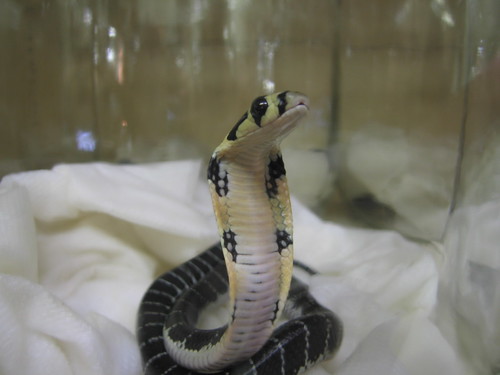
Baby king cobra, Gladys Porter Zoo;
(Photo by WildlifeKat)
The young, which measure up to 60 centimetres in length when they first emerge, are unlike their parents in their conspicuous coloration: black with narrow white or yellow bands. Without the protection of their mother, they are vulnerable to all sorts of predators, which may even include adult king cobras. However, one thing they share in common with the adults is that even at such a young age, their venom is already just as potent and deadly.
The King in the City
Although the king cobra is usually thought of as being restricted to forests, it is quite adaptable and will live near people. Elsewhere, king cobras may be found in plantations, rice paddies, and even near settlements, as long as there is dense vegetation to provide hiding places.
In fact, such places may even ultimately attract king cobras; since there are bound to be rodents wherever people live, snakes that eat rats are lured by the prospects of good feeding opportunities, which in turn provide a rich hunting ground for the king cobra.
King cobras can even be found near densely-populated urban areas, in forest patches. For example, king cobras can still be found in parts of Hong Kong.
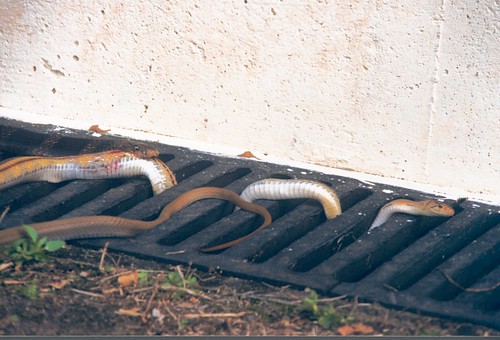
King cobra attacking copperhead racer (Coelognathus radiatus), Hong Kong;
(Photo by hkmoths)
One might even find a king cobra by the roadside, in the act of getting its next meal!
King Cobras in Singapore
The king cobra is known to occur in Singapore, but has not been studied locally. In the latest update of Nature in Singapore, that is now no longer the case, thanks to the efforts of Kelvin Lim, Leong Tzi Ming, and Francis Lim, who published a summary of records of king cobra in Singapore, and compared these sightings with what we already know about king cobras from studies elsewhere.
The first record of king cobra in Singapore dates back to 1847, where it was said to be 'not common'. However, since the 20th century, there have been a number of sightings of king cobras in various parts of Singapore. A large number of reports took place in areas within and surrounding the forests of the Central Nature Reserves, at sites such as Sime Road and Macritchie Reservoir (4 records), Upper Thomson Road (9 records), Rifle Range Road (1 record), Nee Soon swamp forest (1 record), and Bukit Panjang (2 records). Wild king cobras have also been caught within the compound of the Singapore Zoo at Mandai Lake Road (7 records). Other places where king cobras have been found include the Western Catchment Area, at Sarimbun Reservoir (1 record), and Kranji and Sungei Buloh (5 records).

Juvenile king cobra (60 centimetres) found at Segar Road in Bukit Panjang. It was caught by workers while crossing a grass path on 30th March 2000 and donated to the Singapore Zoo;
(Photo by Francis L. K. Lim, published in Lim et al.)
The king cobra has also been found on some of our offshore islands; juvenile king cobras have been found on Pulau Tekong, 1 in 1987 and 2 roadkill specimens in 2006. Even Sentosa, as developed as it is, still retains sufficient patches of vegetation to sustain king cobras: an adult was photographed in 2007.
There are also older records from other parts of Singapore. For example, 2 king cobras were caught near the Naval Base in Sembawang in 1929, and 1 was subsequently sent to the London Zoo. In 1935, an adult was caught in Bras Basah, in the compound of the Malay Volunteer Drill Hall, and in 1972, a policeman shot dead a 3.64 metre long king cobra on the roof of the market in Kampung Bahru.
A number of these individuals are juveniles, which indicates that breeding does occur here. For example, between 1980 and 1982, 4 young juveniles were caught within the compound of the Singapore Zoo. Were they from the same clutch of eggs?

Juvenile king cobra (60 centimetres) caught in the Singapore Zoo compound in June 1982;
(Photo by Francis L. K. Lim, published in Lim et al.)
What can we learn from these sightings?
These sightings indicate that the king cobra is not exactly a very rare species in Singapore, and not only occurs in forests, but also close to human habitation. A book about snakes of Singapore that was written in 1929 mentioned that king cobras seem to have an affinity for roadside drains and culverts; 4 records were of king cobras found in drains.

King cobra in Sundarbans, West Bengal;
(Photo by Paulus Veltman)
While most of the sightings involved seeing the snake on the ground, the record from Sarimbun Reservoir notes that the snake voluntarily entered the water and swam across the reservoir in a leisurely manner, hence confirming the strong swimming abilities of the king cobra. Lim et al. suggest that the narrow Straits of Johor separating Singapore from Peninsular Malaysia would not present much of a barrier to king cobras.

Swimming king cobra, Hong Kong;
(Photo by Tan Kit Sun, shared by robferblue)
Despite the king cobra's fearsome reputation, it is not an aggressive snake by nature; even though it is not uncommon in many parts of its range and can be found living close to people, reports of bites are rare in comparison to those of other venomous snakes. Yes, the bite of the king cobra should never be taken lightly, but it does seem that as a whole, these snakes possess a mild temperament and placid disposition. Some accounts describing the capture of king cobras seem to show that the snake did not attempt to strike even when it had every opportunity to do so. Instead, it appeared to be more intent on trying to get away from people, preferring to use its threat display without following up on the threat with its fangs. Still, there are incidents where the king cobra does mean business and strikes, with dire consequences.
However, this does not prevent the king cobra from being killed by people who are fortunate enough to encounter it. 2 recent reports are of king cobras that had been found on golf courses and subsequently killed, while another cobra was killed in the compound of a house. While there is a need to protect the safety of people, especially where venomous snakes are concerned, there are always other options, such as contacting professionals trained in handling venomous snakes and capturing them in a safe and humane manner.
One of these king cobras is now prominently displayed at the Public Gallery of the Raffles Museum of Biodiversity Research. A male measuring 4.42 metres in length, it was found beaten to death at Singapore Island Country Club.

(Photo by access_2359;)

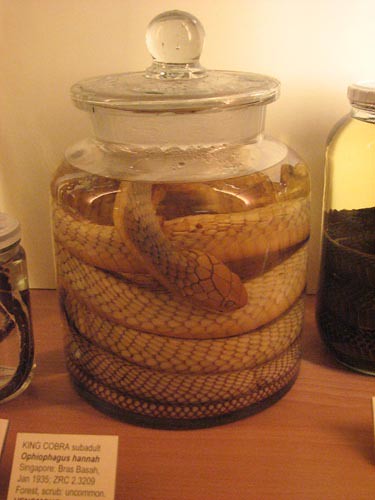
I also found a photo of the smaller individual caught in Bras Basah in 1935;
(Photo by access_2359;)
Another threat that we pose to king cobras is one faced by all animals that take risks trying to cross roads. I've previously posted about reticulated pythons being rescued from becoming roadkill. King cobras too are victims of vehicles; 2 of the records from Pulau Tekong are of roadkilled juveniles, while 2 adults found dead in the Upper Thomson area are suspected to have been mortally injured after being struck by vehicles.

Adult female king cobra roadkill at Island Club Road, 7 August 2009. It measured 3.66 metres in length;
(Photo by H. Y. Kim, published in Lim et al.)
As seen in some of the videos I posted, a king cobra may be especially vulnerable to harassment and disturbance by people if it's seen while feeding or just after having fed. In 1998, a male was found and captured within the Singapore Zoo compound in 1998 while in the act of swallowing a gold-ringed cat snake, and the large male at Rifle Range Road that had swallowed a monitor lizard did not resist capture either.
Some of these snakes that are caught end up being exhibited at the Singapore Zoo. For example, the individual caught at Rifle Range Road was given the name of Ranger, and he lived at the zoo for almost 9 years.

Ranger, a 3.6 metre long male king cobra caught at Rifle Range Road. After capture, he lived at the Singapore Zoo for almost 9 years, and was 4.13 metres long when he died;
(Photo by Francis L. K. Lim, published in Lim et al.)

King cobra, Singapore Zoo;
(Photo by robferblue)
The most recent addition to the Zoo's collection, another large male named Elvis, was caught in a drain along Island Club Road in the Upper Thomson area in March last year, after having swallowed a large snake, presumably a reticulated python. I have not been able to find information as to whether the Zoo has been successful at breeding king cobras in captivity though.

Elvis;
(Photo by Singapore Zoo, published in Lim et al.)
King cobras and people
The king cobra can be considered to be 1 of the more charismatic snakes; it's large, it has a fearsome reputation (not just because it's venomous, but also because it routinely eats other snakes, even venomous ones), and as many people who have been close to one can testify, is a really unique snake. Janaki Lenin, who worked on a National Geographic documentary about king cobras, wrote:
There's something uncanny about the way a king cobra looks you in the eye. It's an indescribable feeling, an encounter with a sentient being. It's about making contact with an entity so utterly different from anything one knows and normally relates to. Keepers say that when they open the door to the king cobra cage, the snake is so perceptive of what's going on; it knows whether the keeper is planning to feed it or whether he is just checking up on it. But it is its majestic restraint that reveals its personality. For the 6 months it took to shoot the film, we were all in such close proximity to king cobras I marvel that no accident took place. And this is more due to the tolerance of the snake than anything else. The more closely we work with an animal, the more we take it for granted. We flaunted our own security protocol several times; each time the king cobra just warned us, mock charging but never carrying it through. This made us respect the creature more than any other.
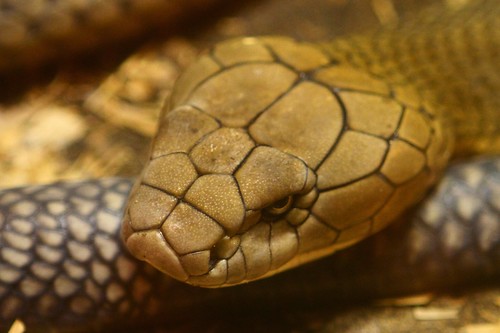
(Photo by Rachit's)
There are a number of accounts which state that king cobras come across as being very alert and observant of their surroundings, even more so compared to other snake species. And some people even state that king cobras can be trained to some degree.
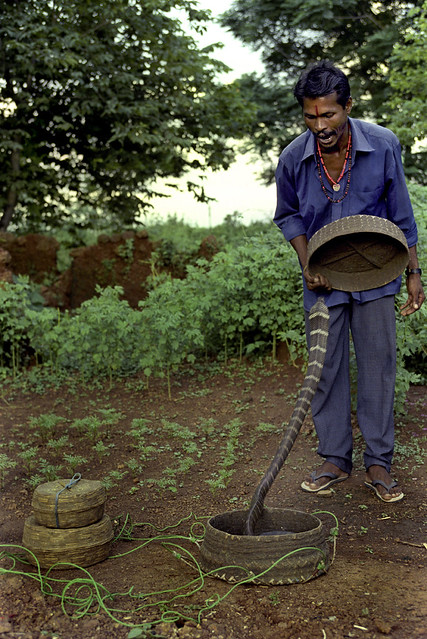
Snake charmer with king cobra, Orissa;
(Photo by adrian fisk)
Unfortunately, like so many other predatory and potentially dangerous species, the king cobra has been the subject of some particularly terrible B-grade monster movies.
Trailer for Komodo vs Cobra
Feared and respected all over the world, the king cobra is a prominent part of many Asian cultures, especially those with a long tradition of snake charming. Although cobras such as the Indian (Naja naja) or monocled cobras (Naja kaouthia) and pythons are more prevalent in snake charming, being able to perform with a king cobra and emerge unscathed is seen as a notable achievement, even today. In so-called snake farms and reptile parks, especially in Thailand, one can find shows where people pit their reflexes against those of an often irritated king cobra.

Kissing a king cobra, Phuket;
(Photo by memoilgaz)
Personally, it's a pity that snake charming is still perceived as a circus show, and does not do much to dispel some of the unnecessary fears about venomous snakes. After all, these shows would lose their draw if they were being done with more harmless snake species. It also does not help that there are so many stories of horrific treatment at the hands of their captors, such as snakes having their fangs pulled out, or their mouths sewn shut. Many captive king cobras are not kept under suitable conditions, and slowly waste away and starve to death while being made to perform for gawking crowds. The stress of having to defend oneself from perceived danger on such a regular basis probably takes its toll on the snakes as well.
In Myanmar, it is said that the snake of choice for snake charming is the king cobra. And while snake charming in most countries seems to be a male-dominated tradition, here women too are involved.
Despite being so revered, king cobras are also hunted and exploited in many countries; snake farms often operate under the guise of extracting venom for research and production of antivenom, but the king cobras are also used for other purposes. Many of these farms are marketed as tourist attractions, and revenue can be earned from tourists coming to watch performances with king cobras.
Cobras are not as heavily harvested for their skins like pythons, but they are still important in the Asian leather trade. The monocled cobra is the most important species farmed for snakeskin, while products made from king cobra leather are less common but available in the market.
Cobras raised on these farms may end up preserved, either as taxidermy specimens, or in jars of rice wine. The practice of immersing various venomous animals into a bottle of liquor and left to steep is widespread throughout much of Asia, and the resulting brew is supposed to be drunk as a tonic. A lot of these products are not meant for local consumption, but are sold to tourists as souvenirs; a number of tourists, wanting to bring home a memento of exotic Asia, end up purchasing a bottle of snake wine or a poorly taxidermied cobra to gather dust on a shelf.
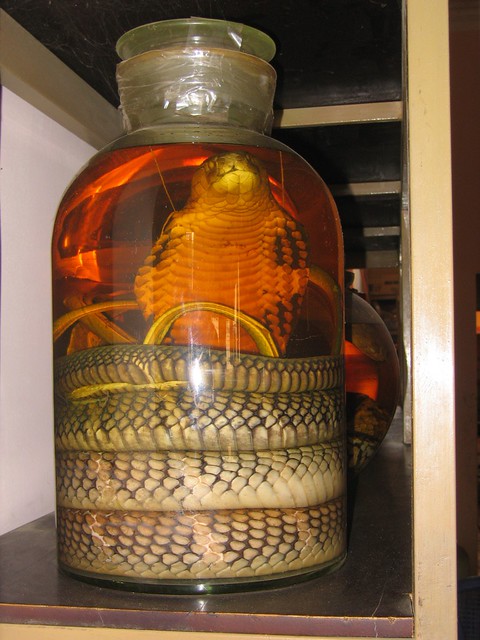
King cobra in rice wine, Saigon;
(Photo by thdoan)
At some restaurants specialising in exotic meat, one can find cobras being decapitated and slit open, the blood drained from the still-writhing snake, to be mixed in with wine and drunk from a shot glass, also for its supposed health benefits. The meat as well as organs such as the heart (often still beating) and gall bladder are also consumed. In Hong Kong, snake meat (including that of king cobras) is most often served in a soup during the winter months.

King cobra at a shop that serves snake dishes, Hong Kong;
(Photo by eWinter)

King cobra soup, Hanoi;
(Photo by maibrian)
Not all this trade is legal; the king cobra is listed on Appendix II of CITES, which means that one needs the proper certificates before international trade in king cobras or products made from king cobra can legally take place. Such trade can take the form of wild-caught snakes for herpetological collections, or jars of king cobra wine, or taxidermy specimens. King cobras are also protected in some countries, but that does not always stop poachers and smugglers from feeding the markets.
Shrinking kingdom
The king cobra is currently listed as Vulnerable on the IUCN Red List, but little is known about the population trends in the wild. Presumably, deforestation plays a part; king cobras are after all primarily forest snakes. Loss of habitat means that king cobras may range into inhabited areas, which puts them at risk of being killed by people. If these individuals are not killed outright, they may end up being caught for snake meat restaurants or snake farms. It does not help that there is very heavy trade in many Asian species of snake for various reasons, which probably reduces the amount of prey available for wild king cobras.

Captive king cobra at Penang Snake Temple. Its nose is probably raw from rubbing against the metal wire surrounding its enclosure;
(Photo by cabreney.jm)
While snake farms do help relieve the pressure on wild populations, it is not known whether these are truly sustainable. After all, there is the possibility that these farms supplement their stock with wild-caught cobras, or that wild-caught cobras are processed through these farms and labeled as captive-bred; records of the numbers of king cobras being traded are not always accurate. And since king cobras eat primarily other snakes, the simplest solution is often to purchase large numbers of rat snakes or other snakes (usually wild-caught) for food. This of course may have a heavy impact on the wild populations of other snake species.

This king cobra looks like it's horrified at being kissed, Sentosa;
(Photo by jaeWALK)
In many ways, the plight of this snake illustrates the common challenges of conserving large predators: the king cobra is constrained by ever-shrinking forests and declining prey base, and individuals wander into inhabited areas where they come into conflict with people. It is heavily exploited and consumed, not just by locals but also by tourists. Captives are often abused and subjected to the stress of performing for crowds of people. Yet at the same time, it is respected and revered by these very same cultures. If there is another iconic Asian animal that shares the very same problems faced by the king cobra, it is the tiger (Panthera tigris). Snakes just can't compare in popularity to big cats.
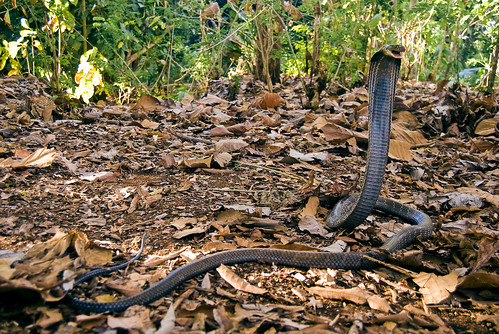
King cobra, Bali;
(Photo by chaz79)
While the king cobra is not often spotted in Singapore, the reports listed in Lim et al. show that it still persists and even manages to breed in several parts of the country. If reptiles can qualify as part of the charismatic megafauna, this would certainly be 1 of them. It can never truly draw the ecotourists like the Malayan water monitors (Varanus salvator) and estuarine crocodiles (Crocodylus porosus) of Sungei Buloh, but I'm sure the possibility of having an encounter with a king cobra makes a trip to Macritchie or Bukit Timah just that bit more exciting. May our forests continue to be ruled by this most regal of all serpents.
Lim, K. K. P., T. M. Leong & F. L. K. Lim, 2011. The king cobra, Ophiophagus hannah (Cantor) in Singapore (Reptilia: Squamata: Elapidae). Nature in Singapore, 4: 143–156. [PDF]